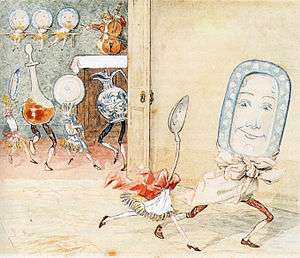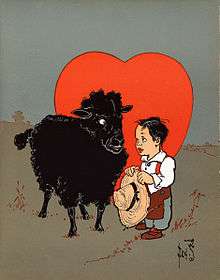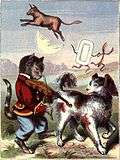Nursery rhyme

A nursery rhyme is a traditional poem or song for children in Britain and many other countries, but usage of the term only dates from the late 18th/early 19th century. In North America the term Mother Goose Rhymes, introduced in the mid-18th century, is still often used.[1]
From the mid-16th century they begin to be recorded in English plays, and most popular nursery rhymes date from the 17th and 18th centuries.[2] The first English collections, Tommy Thumb's Song Book and a sequel, Tommy Thumb's Pretty Song Book, were published before 1744. John Newbery's compilation of English rhymes, Mother Goose's Melody, or, Sonnets for the Cradle (London, c. 1765), is the first record we have of many classic rhymes, still in use today.[3]
History
Lullabies
The oldest children's songs of which we have records are lullabies, intended to help a child sleep. Lullabies can be found in every human culture.[4] The English term lullaby is thought to come from "lu, lu" or "la la" sounds made by mothers or nurses to calm children, and "by by" or "bye bye", either another lulling sound or a term for good night.[5] Until the modern era lullabies were usually only recorded incidentally in written sources. The Roman nurses' lullaby, "Lalla, Lalla, Lalla, aut dormi, aut lacta", is recorded in a scholium on Persius and may be the oldest to survive.[6]
Many medieval English verses associated with the birth of Jesus take the form of a lullaby, including "Lullay, my liking, my dere son, my sweting" and may be versions of contemporary lullabies.[5] However, most of those used today date from the 17th century. For example, a well known lullaby such as "Rock-a-bye, baby on a tree top", cannot be found in records until the late-18th century when it was printed by John Newbery (c. 1765).[5]
Early nursery rhymes
A French poem, similar to "Thirty days hath September", numbering the days of the month, was recorded in the 13th century.[7] From the later Middle Ages there are records of short children's rhyming songs, often as marginalia.[8] From the mid-16th century they begin to be recorded in English plays.[2] "Pat-a-cake, pat-a-cake, baker's man" is one of the oldest surviving English nursery rhymes. The earliest recorded version of the rhyme appears in Thomas d'Urfey's play The Campaigners from 1698. Most nursery rhymes were not written down until the 18th century, when the publishing of children's books began to move from polemic and education towards entertainment, but there is evidence for many rhymes existing before this, including "To market, to market" and "Cock a doodle doo", which date from at least the late 16th century.[9]
The first English collections, Tommy Thumb's Song Book and a sequel, Tommy Thumb's Pretty Song Book, are both thought to have been published before 1744, with such songs becoming known as 'Tommy Thumb's songs'.[10] The publication of John Newbery's compilation of English rhymes, Mother Goose's Melody, or, Sonnets for the Cradle (London, c. 1765), is the first record we have of many classic rhymes, still in use today.[3][11] These rhymes seem to have come from a variety of sources, including traditional riddles, proverbs, ballads, lines of Mummers' plays, drinking songs, historical events, and, it has been suggested, ancient pagan rituals.[1] About half of the currently recognised "traditional" English rhymes were known by the mid-18th century.[12]
19th century
In the early 19th century printed collections of rhymes began to spread to other countries, including Robert Chambers's Popular Rhymes of Scotland (1826) and in the United States, Mother Goose's Melodies (1833).[1] From this period we sometimes know the origins and authors of rhymes—for instance, in "Twinkle Twinkle Little Star" which combines the melody of an 18th-century French tune "Ah vous dirai-je, Maman" with a 19th-century English poem by Jane Taylor entitled "The Star" used as lyrics.
Early folk song collectors also often collected (what are now known as) nursery rhymes, including in Scotland Sir Walter Scott and in Germany Clemens Brentano and Achim von Arnim in Des Knaben Wunderhorn (1806–1808).[13] The first, and possibly the most important academic collection to focus in this area was James Orchard Halliwell's, The Nursery Rhymes of England (1842) and Popular Rhymes and Tales in 1849, in which he divided rhymes into antiquities (historical), fireside stories, game-rhymes, alphabet-rhymes, riddles, nature-rhymes, places and families, proverbs, superstitions, customs, and nursery songs (lullabies).[14] By the time of Sabine Baring-Gould's A Book of Nursery Songs (1895), folklore was an academic study, full of comments and foot-notes. A professional anthropologist, Andrew Lang (1844–1912) produced The Nursery Rhyme Book in 1897. The early years of the 20th century are notable for the illustrations to children's books including Caldecott's Hey Diddle Diddle Picture Book (1909) and Arthur Rackham's Mother Goose (1913). The definitive study of English rhymes remains the work of Iona and Peter Opie.[12]
Meanings of nursery rhymes
Many nursery rhymes have been argued to have hidden meanings and origins. John Bellenden Ker (1765?–1842), for example, wrote four volumes arguing that English nursery rhymes were actually written in 'Low Saxon', a hypothetical early form of Dutch. He then 'translated' them back into English, revealing in particular a strong tendency to anti-clericalism.[15][16] Many of the ideas about the links between rhymes and historical persons, or events, can be traced back to Katherine Elwes's book The Real Personages of Mother Goose (1930), in which she linked famous nursery-rhyme characters with real people, on little or no evidence. She assumed that children's songs were a peculiar form of coded historical narrative, propaganda or covert protest, and rarely considered that they could have been written simply for entertainment.[15][17]
| Title | Supposed origin | Earliest date known | Meaning supported by evidence |
|---|---|---|---|
| "Baa, Baa, Black Sheep" | The slave trade; medieval wool tax | c. 1744 (Britain) | Medieval taxes were much lower than two thirds. There is no evidence of a connection with slavery.[18] |
| "Doctor Foster" | Edward I of England | 1844 (Britain) | Given the recent recording the medieval meaning is unlikely.[18] |
| "Goosey Goosey Gander" | Henry VIII of England | 1784 (Britain) | No evidence that it is linked to the propaganda campaign against the Catholic Church during the reign of King Henry VIII.[19] |
| "The Grand Old Duke of York" | Richard Plantagenet, 3rd Duke of York in the Wars of the Roses; James II of England, or Prince Frederick, Duke of York and Albany Flanders campaign of 1794–5. | 1913 (Britain) | The more recent campaign is more likely, but first record is very late. The song may be based on a song about the king of France.[20] |
| "Humpty Dumpty" | Richard III of England; Cardinal Wolsey and a cannon from the English Civil War | 1797 (Britain) | No evidence that it refers to any historical character and is originally a riddle found in many European cultures. The story about the cannon is based on a spoof verse written in 1956.[18][21] |
| "Jack and Jill" | Norse mythology; Charles I of England; Louis XVI of France and Marie Antoinette | 1765 (Britain) | No evidence that it stretches back to early medieval era and poem predates the French Revolution.[18] |
| "Little Boy Blue" | Thomas Wolsey | c. 1760 (Britain) | Unknown, the identification is speculative.[18] |
| "Little Jack Horner" | Dissolution of the Monasteries | 1725 (Britain), but story known from c. 1520 | The rhyme may have been adapted to satirise Thomas Horner who benefited from the Dissolution, but the connection is speculative.[18] |
| "London Bridge Is Falling Down" | Burial of children in foundations; burning of wooden bridge by Vikings | 1659 (Britain) | Unknown, but verse exists in many cultures and may have been adapted to London when it reached England.[18] |
| "Mary Had a Little Lamb" | An original poem by Sarah Josepha Hale inspired by an actual incident. | 1830 (USA) | As a girl, Mary Sawyer (later Mrs. Mary Tyler) kept a pet lamb, which she took to school one day at the suggestion of her brother.[22] |
| "Mary, Mary, Quite Contrary" | Mary, Queen of Scots, or Mary I of England | c. 1744 (Britain) | Unknown, all identifications are speculative.[18] |
| "Old King Cole" | Various early medieval kings and Richard Cole-brook a Reading clothier | 1708–9 (Britain) | Richard Cole-brook was widely known as King Cole in the 17th century.[18] |
| "Ring a Ring o' Roses" | Black Death (1348) or The Great Plague of London (1665) | 1790 (Britain) | No evidence that the poem has any relation to the plague. The 'plague' references are not present in the earliest versions.[15][18] |
| "Rock-a-bye Baby" | The Egyptian god Horus; Son of James II of England preceding the Glorious Revolution; Native American childcare; anti-Jacobite satire | c. 1765 (Britain) | Unknown, all identifications are speculative.[18] |
| "There was an Old Woman Who Lived in a Shoe" | Queen Caroline of Ansbach; Queen Caroline, wife of King George II of Great Britain; Elizabeth Vergoose of Boston. | 1784 (Britain) | Unknown, all identifications are speculative.[18] |
| "Three Blind Mice" | Mary I of England | c. 1609 (Britain) | Unknown, the identification is speculative.[18] |
| "Who Killed Cock Robin?" | Norse mythology; Robin Hood; William Rufus; Robert Walpole; Ritual bird sacrifice | c. 1744 (Britain) | The story, and perhaps rhyme, dates from at least the later medieval era, but all identifications are speculative.[18] |
Nursery rhyme revisionism

There have been several attempts, across the world, to revise nursery rhymes (along with fairy tales and popular songs). Even in the late 18th century we can sometimes see how rhymes like "Little Robin Redbreast" were cleaned up for a young audience.[23] In the late 19th century the major concern seems to have been violence and crime, which led leading children's publishers in the United States like Jacob Abbot and Samuel Goodrich to 'improve' Mother Goose rhymes.[24]
In the early and mid-20th centuries this was a form of bowdlerisation, concerned with some of the more violent elements of nursery rhymes and led to the formation of organisations like the British 'Society for Nursery Rhyme Reform'.[25] Psychoanalysts such as Bruno Bettelheim strongly criticized this revisionism, on the grounds that it weakened their usefulness to both children and adults as ways of symbolically resolving issues and it has been argued that revised versions may not perform the functions of catharsis for children, or allow them to imaginatively deal with violence and danger.[26]
In the late 20th century revisionism of nursery rhymes became associated with the idea of political correctness. Most attempts to reform nursery rhymes on this basis appear to be either very small scale, light-hearted updating, like Felix Dennis's When Jack Sued Jill – Nursery Rhymes for Modern Times (2006), or satires written as if from the point of view of political correctness in order to condemn reform.[27] The controversy in Britain in 1986 over changing the language of "Baa Baa Black Sheep" because, it was alleged in the popular press, it was seen as racially dubious, was apparently based only on a rewriting of the rhyme in one private nursery, as an exercise for the children.[28]
Nursery rhymes and education
It has been argued that nursery rhymes set to music aid in a child's development.[29][30] Research also supports the assertion that music and rhyme increase a child's ability in spatial reasoning, which aid mathematics skills.[31]
See also
| Wikimedia Commons has media related to Nursery rhymes. |
Notes
- 1 2 3 H. Carpenter and M. Prichard, The Oxford Companion to Children's Literature (Oxford University Press, 1984), p. 383.
- 1 2 A. Fox, Oral and Literate Culture in England, 1500–1700 (Oxford University Press, 2000), p. 202.
- 1 2 A. H. Bullen's 1904 facsimile of Newbery's 1791 edition of Mother Goose's Melody(on-line)
- ↑ I. Opie and P. Opie, The Oxford Dictionary of Nursery Rhymes (Oxford: Oxford University Press, 1951, 2nd edn., 1997), p. 6.
- 1 2 3 H. Carpenter and M. Prichard, The Oxford Companion to Children's Literature (Oxford University Press, 1984), p. 326.
- ↑ I. Opie and P. Opie, The Oxford Dictionary of Nursery Rhymes (Oxford University Press, 1951, 2nd edn., 1997), p. 6.
- ↑ "Nursery Rhyme", Encyclopædia Britannica, retrieved 20 September 2013.
- ↑ S. Lerer, Children's Literature: a Reader's History, from Aesop to Harry Potter (University of Chicago Press, 2008), pp. 69–70.
- ↑ I. Opie and P. Opie, The Oxford Dictionary of Nursery Rhymes (Oxford University Press, 1951, 2nd edn., 1997), pp. 30–1, 47–8, 128–9 and 299.
- ↑ H. Carpenter and M. Prichard, The Oxford Companion to Children's Literature (Oxford University Press, 1984), pp. 382–3.
- ↑ H. Carpenter and M. Prichard, The Oxford Companion to Children's Literature (Oxford University Press, 1984), pp. 363–4.
- 1 2 I. Opie and P. Opie, The Oxford Dictionary of Nursery Rhymes (Oxford University Press, 1951, 2nd edn., 1997).
- ↑ H. Carpenter and M. Prichard, The Oxford Companion to Children's Literature (Oxford University Press, 1984), p. 384.
- ↑ R. M. Dorson, The British Folklorists: a History (Taylor & Francis, 1999), p. 67.
- 1 2 3 D. Wilton, I. Brunetti, Word myths: debunking linguistic urban legends (Oxford: Oxford University Press US, 2004), pp. 24–5.
- ↑ H. Carpenter and M. Prichard, The Oxford Companion to Children's Literature (Oxford University Press, 1984), p. 290.
- ↑ I. Opie, 'Playground rhymes and the oral tradition', in P. Hunt, S. G. Bannister Ray, International Companion Encyclopedia of Children's Literature (London: Routledge, 2004), p. 179.
- 1 2 3 4 5 6 7 8 9 10 11 12 13 14 I. Opie and P. Opie, The Oxford Dictionary of Nursery Rhymes (Oxford: Oxford University Press, 1951, 2nd edn., 1997).
- ↑ C. Roberts, Heavy words lightly thrown: the reason behind the rhyme (Granta, 2004), p. 23.
- ↑ E. Knowles, Oxford Dictionary of Quotations (Oxford: Oxford University Press, 1941, 6th edn., 2004).
- ↑ I. Opie, 'Playground rhymes and the oral tradition', in P. Hunt, S. G. Bannister Ray, International Companion Encyclopedia of Children's Literature (London: Routledge, 2004), p. 176.
- ↑ Roulstone, John; Mary (Sawyer) and her friends (1928). The Story of Mary's Little Lamb. Dearborn: Mr. & Mrs. Henry Ford.
- ↑ I. Opie and P. Opie, The Oxford Dictionary of Nursery Rhymes (Oxford: Oxford University Press, 1951, 2nd edn., 1997), pp. 371–2.
- ↑ S. Wadsworth, In the Company of Books: Literature and Its "classes" in Nineteenth-century America (Liverpool: Liverpool University Press, 2006), p. 22.
- ↑ N. E. Dowd, D. G. Singer, R. F. Wilson. Handbook of children, culture, and violence (Sage, 2005), p. 136.
- ↑ Jack Zipes, The Brothers Grimm: From Enchanted Forests to the Modern World, p. 48, ISBN 0-312-29380-1.
- ↑ F. Dennis, When Jack Sued Jill – Nursery Rhymes for Modern Times (Ebury, 2006).
- ↑ J. Curran, J. Petley, I. Gaber, Culture wars: the media and the British left (Edinburgh: Edinburgh University Press, 2005), pp. 85–107.
- ↑ "About Us - Canticos". canticosworld.com. Retrieved 2016-11-16.
- ↑ R. Bayley, Foundations of Literacy: A Balanced Approach to Language, Listening and Literacy Skills in the Early Years, 2004.
- ↑ Associated Press, "Study says preschool music lessons may aid math skills", Chicago Tribune, August 14, 1994.
